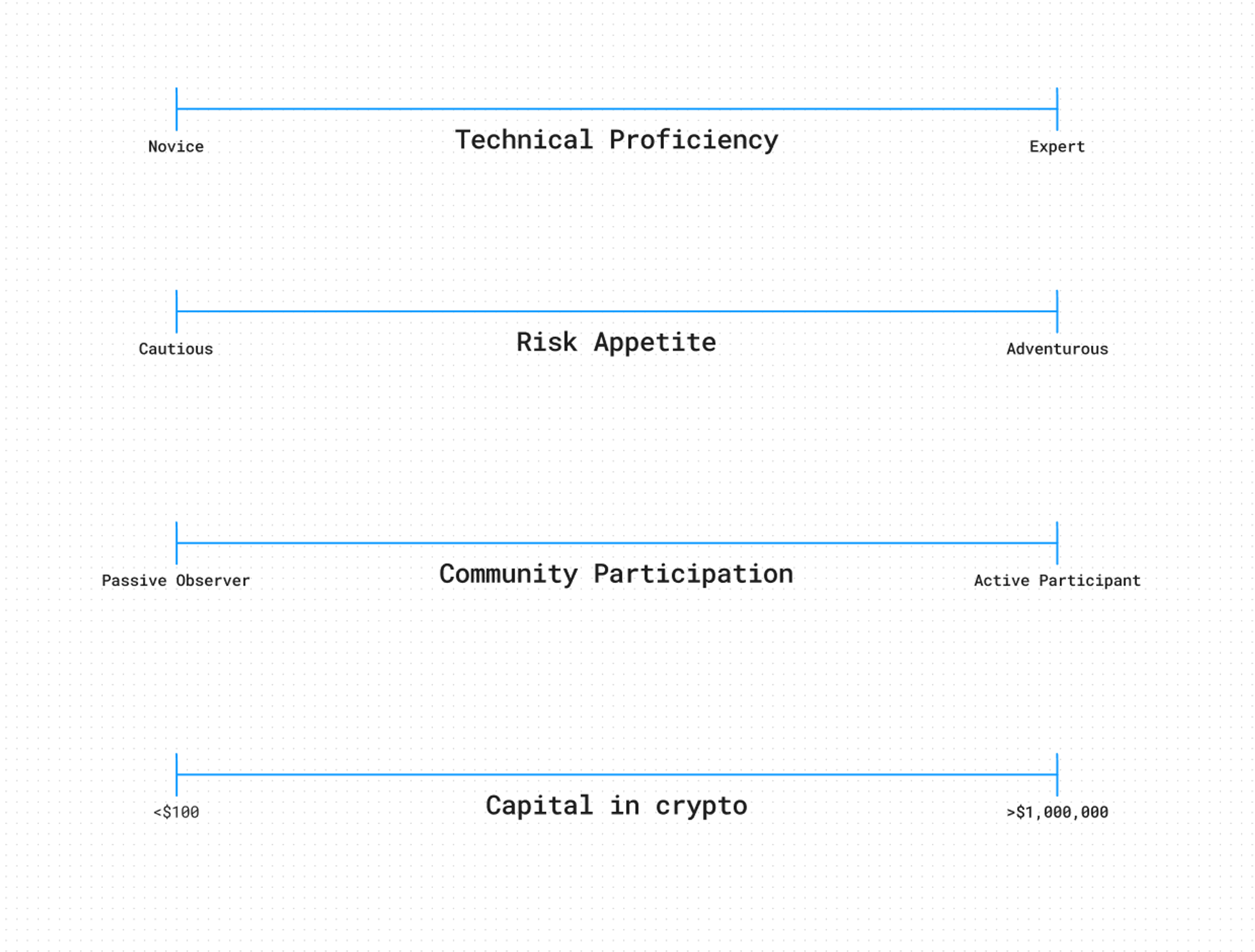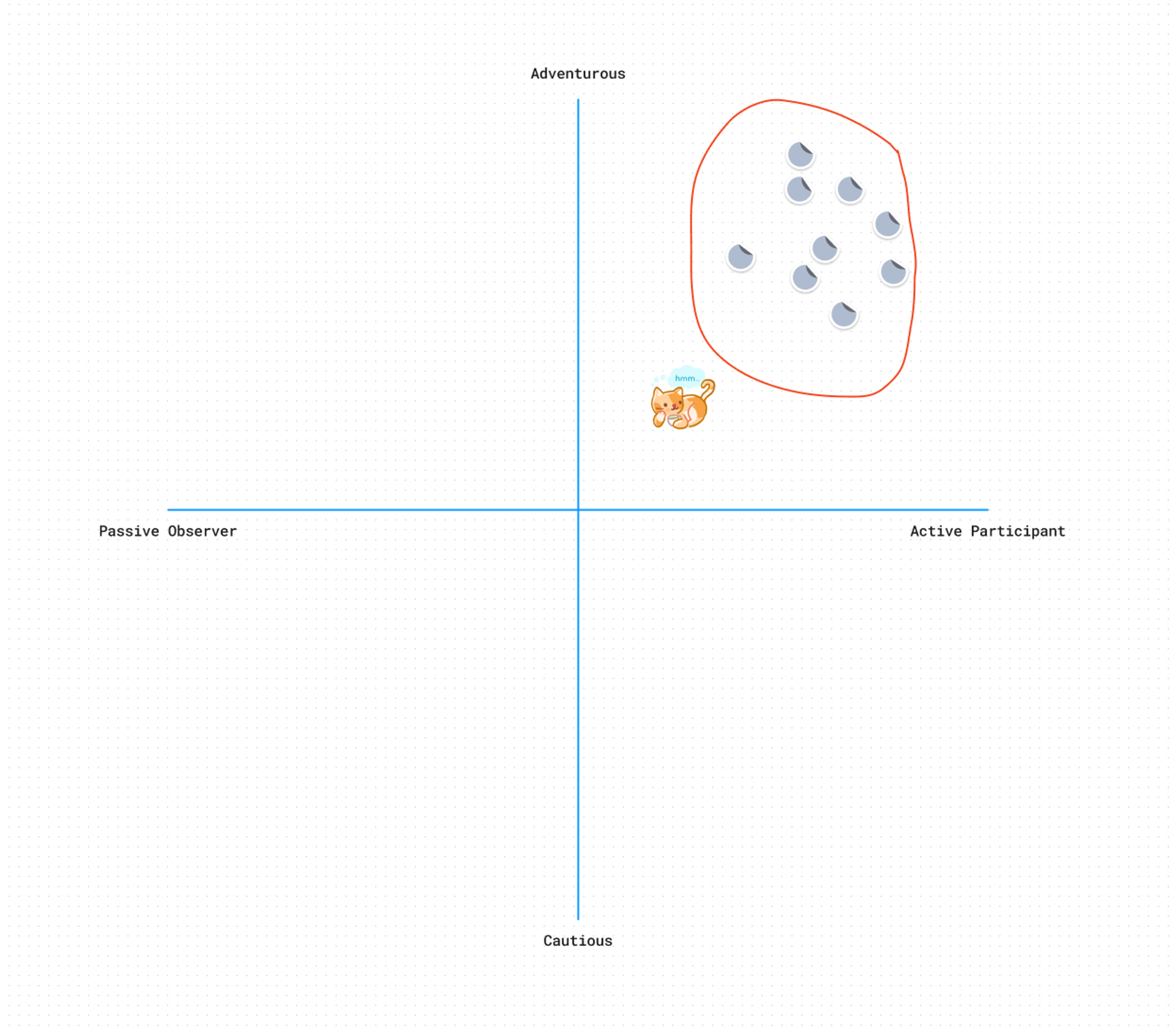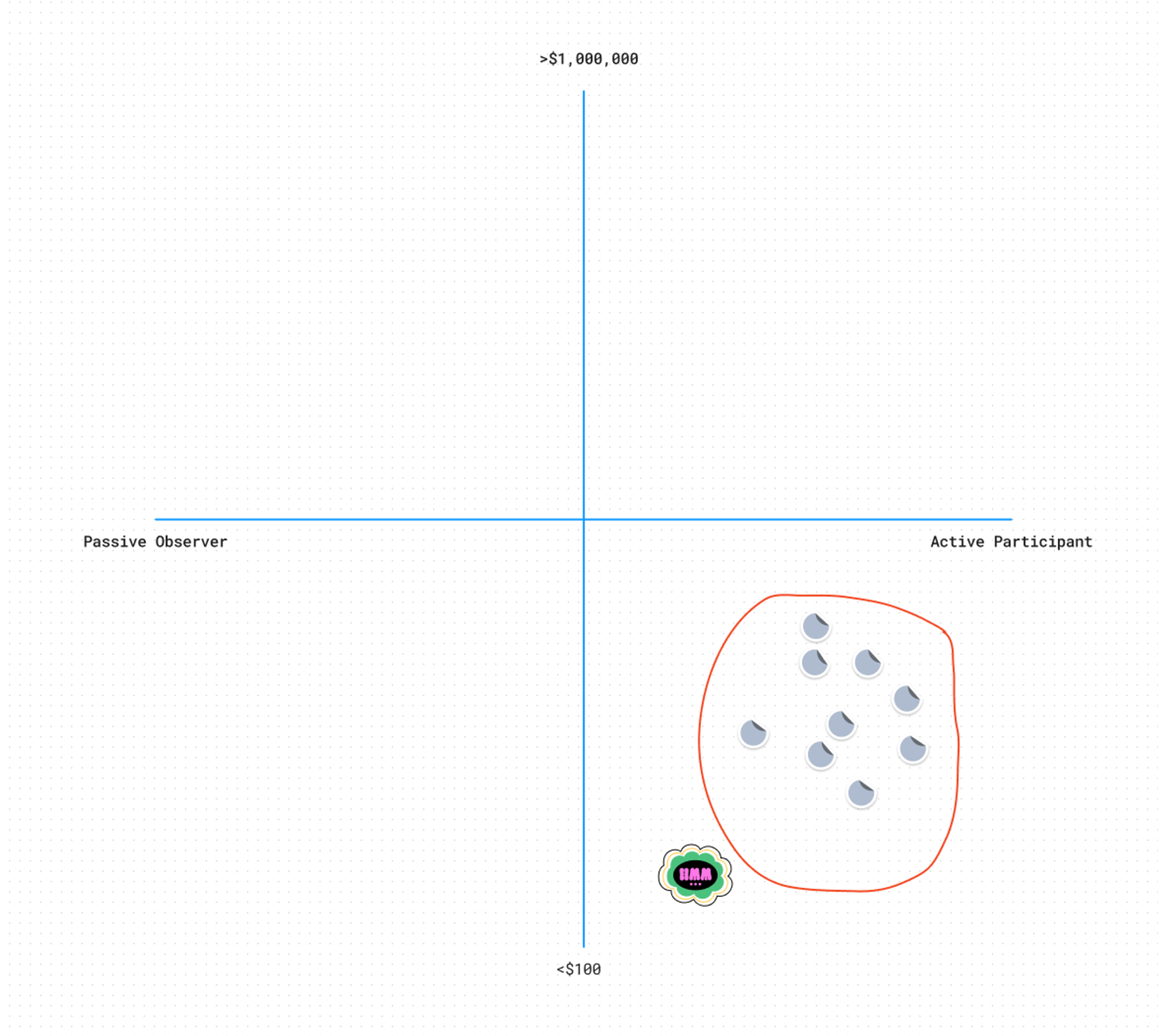This pairs with the web3 proto-personas.

The problem with personas
- Web3 is so big, we’re really talking about multiple industries at this point
- Anonymity is valued highly
- Web3 is an international, decentralised, phenomena, so any questions/assumptions/data about demographics become complex and hard to parse
Lets expand on these points.
👨👩👧👦 Web3 is so big, we’re really talking about multiple industries at this point
If you’re going to make personas, they need to be specific to whatever your actual dApp does. Users of Convex will be different to users of Pancakeswap. In fact, users of Ethereum are quite different to users of Binance Smart Chain. NFT traders are (interestingly) quite different from DeFi users. Users of complex financial tools like options will be different again from a user who just provides liquidity. A general “DeFi user” persona is of little relevance to any one specific app.
🐸 Anonymity is valued highly
A lot of users will simply not answer certain questions.
🎭 Web3 is decentralised, demographics are complex, this is a challenging area to get your head around etc
Many in web3 love the fact that it is decentralised and anonymous. Several of the biggest names building the space are pseudonymous and use NFTs as pfps. Most teams are internationally diverse. I’ve worked with some people for years, and I don’t know their real name, their pronouns, and have never seen their face. People can be amusingly stubborn about this - Scoopy Trooples was asked in an interview about the pseudonym and their response was “Well, this is my real face. I am a 2D character. Let's make that clear.” Web3 lawyer Wassielawyer insists that any article quoting him must refer to him as “a hentai anime penguin”. This culture is reflected among users as well. Female avatars like Miladys are popular pfps for users of any gender. It’s hard to infer much of anything from someone’s name or avatar. So if the whole point is that nobody knows who you are, or where you are, or what you are, why should we care? This becomes a bit philosophical, because actually demographics can be important and you could probably come up with a dozen reasons why we should care. But on the other hand…
🤡 Personas are often bullshit anyway
While they can be useful tools for building empathy and aligning teams, they often devolve into little more than creative writing exercises. They end up being way too specific, and filled with nonsensical details.
You know the type…
“Meet Savvy Sally, the Discount Diva! Sally can sniff out a sale from miles away. Armed with her smartphone, she has mastered the art of coupon clipping, price comparisons, and timing her shopping sprees to perfection. Loyalty cards are her secret weapons. Savvy Sally is a master at accumulating reward points and cashing them in for exclusive perks and freebies! She is 32 years old, drinks a frappuccino at 10am each morning, and watches 2hrs and 20 minutes of Netflix at 8pm each evening. Here are her favourite shows and here are some quotes we’ve put in her mouth! Also, her eyes are blue.”
Most of the time, these aren’t even really based on anything except the imagination of the person writing them.
📊 You need a lot of data to do them properly
A better way is to generate very large datasets, then run factor analysis in order to find hidden clusters. From there, you can use assorted statistical techniques to tease out more patterns. The problem is that most people are not data scientists and don’t know what they’re doing with R and python, so at this point, the whole thing breaks down.
A way forward
Web3 personas are most useful when they:
- Are specific to each app, and target exact user types
- Focus on behaviour and not demographics (which is good UX advice in general tbh).
Qualitative personas are fine for getting things rolling. But if you were to collect some more data, you could make statistical personas. I keep hoping some team with deep pockets will actually do large-scale research like this, but so far it hasn’t happened. 😞
Consensys did a recent Global Survey on Crypto and Web3, which is interesting but also a bit of a missed opportunity, because it focuses on all the right things for a nice report, but all the wrong things for anybody building the bloody apps! sigh
Conducting an actual factor analysis would require a comprehensive survey with a wide range of Web3 users. However, based on the common characteristics anecdotally observed in Web3/Defi users, we can hypothesize some potential main factors that might emerge from such an analysis. These factors could represent different categories. We could also derive axes of user characteristics for each category.
I must stress this is hypothetical, but even so, this gets much more interesting, and much more useful, than the proto-personas described at the top.
- Technical Proficiency:
- This factor would capture the level of technical knowledge and familiarity with blockchain technology and cryptocurrencies.
- Axis: Novice to Expert.
- Risk Appetite:
- This factor would reflect the users’ willingness to take on risks in their DeFi investments and activities.
- Axis: Cautious to Adventurous.
- Financial Goals:
- This factor would represent the various financial objectives and motivations driving users' engagement with DeFi.
- Axes: Income Generation to Capital Appreciation, Long-term to Short-term Goals.
- Financial Background:
- This factor would encompass users’ prior experience and understanding of traditional financial systems and investments.
- Axis: Traditional Finance Background to No Prior Finance Experience.
- Community Participation:
- This factor would represent users’ involvement in DeFi communities, governance, and collaboration with other users and projects.
- Axis: Passive Observer to Active Community Participant.
- Privacy and Security Concerns:
- This factor would capture users’ attitudes towards privacy and security when using DeFi protocols.
- Axis: Security-Conscious to Less Concerned about Security.
Technical knowledge is so important that some teams basically just stratify their users by that. They don’t really have “personas”, they just keep in mind that users will have different levels of DeFi knowledge. Not very creative, but probably more useful.
Another useful scale would be simply “how much money do you have?”
I suspect this might overpower almost any other factor in explaining behaviour. For example, during 2020-2022, we observed pronounced user differences between apps on different chains. It seemed like the Ethereum community was different from the emergent BSC community. The biggest reason? Gas fees were highest on Ethereum, meaning those with less capital were priced out of the action. Any other demographic difference based on geographical location, education, sex, age etc was far less relevant than just how wealthy you were.
It’s also important to note that within each persona, there will be variations along each axis.
Maybe instead of personas, we should just try and plot our users along some of theses axes? Even if you have to make some guesses?

Once you’ve done that, you could even plot two together and look at the relationships between characteristics.
Again, totally hypothetical, but you might notice eg: a positive correlation between active community participants and how adventurous they are trying new defi opportunities.

Or maybe you’ll notice a negative correlation between how active they are in the community, and how much money they have. This might give you useful pointers on how to engage with the community. It’s not a persona, but it’s actionable insight.

Possibly once you’ve done this, you’ll have a good idea of your user and you can then make a characteristic-focused persona. Or maybe you just just stick with the axes.
At the end of the day, both qualitative and quantitive research methods have their place, but unless we’re talking about very specific segments, and/or we have much better data, I feel uncomfortable talking about who the “typical web3 user” is.
I’ve been working in crypto since 2017 and this is a big change in my thinking.
Sometimes, the more you know, the less you know.